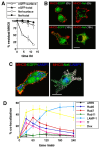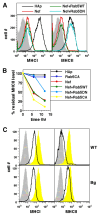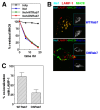HIV-1 Nef promotes endocytosis of cell surface MHC class II molecules via a constitutive pathway
- PMID: 19620308
- PMCID: PMC7616452
- DOI: 10.4049/jimmunol.0804014
HIV-1 Nef promotes endocytosis of cell surface MHC class II molecules via a constitutive pathway
Erratum in
- J Immunol. 2009 Dec 1;183(11):7611
Abstract
HIV-1 Nef has been reported to disrupt MHC class II (MHCII)-mediated Ag presentation by a dual strategy that comprises a reduction in cell surface levels of peptide-loaded mature MHCII molecules and a up-regulation of immature MHCII molecules. We show that Nef achieves relocation of MHCII away from the cell surface in monocytic cells by both delaying its transport to the cell surface and by accelerating endocytic removal of cell surface MHCII to a lysosomal compartment. Nef-induced MHCII endocytosis is cholesterol-sensitive but clathrin- and dynamin-independent. Internalized MHCII molecules traverse the early endosomal system and colocalize with pinocytic cargo before reaching lysosomes. Nef-triggered MHCII endocytosis requires Rab5 activity and lyst function, whereas lysosomal trafficking of internalized MHCII molecules requires Rab7 activity. We further show that a similar pathway can remove peptide-MHCII complexes from the surface of monocytic cells not expressing Nef. Our data suggest that Nef uses mechanisms involved in normal MHCII recycling and turnover to mediate the delivery of cell surface MHCII to a lysosomal destination. Thus, Nef-mediated endocytosis of MHCII provides a novel perspective on the regulation of normal MHCII trafficking.
Conflict of interest statement
The authors declare that they have no competing financial interests.
Figures






Similar articles
-
Endocytosis of major histocompatibility complex class I molecules is induced by the HIV-1 Nef protein.Nat Med. 1996 Mar;2(3):338-42. doi: 10.1038/nm0396-338. Nat Med. 1996. PMID: 8612235
-
Endosomally stored MHC class II does not contribute to antigen presentation by dendritic cells at inflammatory conditions.Traffic. 2011 Aug;12(8):1025-36. doi: 10.1111/j.1600-0854.2011.01212.x. Epub 2011 May 13. Traffic. 2011. PMID: 21518167
-
Nef-mediated disruption of HLA-A2 transport to the cell surface in T cells.J Virol. 2003 Mar;77(5):3041-9. doi: 10.1128/jvi.77.5.3041-3049.2003. J Virol. 2003. PMID: 12584329 Free PMC article.
-
[The HIV nef and the Kaposi-sarcoma-associated virus K3/K5 proteins: "parasites"of the endocytosis pathway].Med Sci (Paris). 2003 Jan;19(1):100-6. doi: 10.1051/medsci/2003191100. Med Sci (Paris). 2003. PMID: 12836198 Review. French.
-
Nef--an adaptor adaptor?Trends Cell Biol. 1998 Aug;8(8):302-5. doi: 10.1016/s0962-8924(98)01318-x. Trends Cell Biol. 1998. PMID: 9704405 Review.
Cited by
-
HIV-1 Nef binds a subpopulation of MHC-I throughout its trafficking itinerary and down-regulates MHC-I by perturbing both anterograde and retrograde trafficking.J Biol Chem. 2010 Oct 1;285(40):30884-905. doi: 10.1074/jbc.M110.135947. Epub 2010 Jul 9. J Biol Chem. 2010. PMID: 20622010 Free PMC article.
-
Remodeling of the Host Cell Plasma Membrane by HIV-1 Nef and Vpu: A Strategy to Ensure Viral Fitness and Persistence.Viruses. 2016 Mar 3;8(3):67. doi: 10.3390/v8030067. Viruses. 2016. PMID: 26950141 Free PMC article. Review.
-
Pulsed stable isotope labeling of amino acids in cell culture uncovers the dynamic interactions between HIV-1 and the monocyte-derived macrophage.J Proteome Res. 2011 Jun 3;10(6):2852-62. doi: 10.1021/pr200124j. Epub 2011 May 3. J Proteome Res. 2011. PMID: 21500866 Free PMC article.
-
Herpes Simplex Virus 1 UL34 Protein Regulates the Global Architecture of the Endoplasmic Reticulum in Infected Cells.J Virol. 2017 May 26;91(12):e00271-17. doi: 10.1128/JVI.00271-17. Print 2017 Jun 15. J Virol. 2017. PMID: 28356536 Free PMC article.
-
HIV and tuberculosis: a deadly human syndemic.Clin Microbiol Rev. 2011 Apr;24(2):351-76. doi: 10.1128/CMR.00042-10. Clin Microbiol Rev. 2011. PMID: 21482729 Free PMC article. Review.
References
-
- Kestler HW, III, Ringler DJ, Mori K, Panicali DL, Sehgal PK, Daniel MD, Desrosiers RC. Importance of the nef gene for maintenance of high virus loads and for development of AIDS. Cell. 1991;65:651–662. - PubMed
-
- Hanna Z, Kay DG, Rebai N, Guimond A, Jothy S, Jolicoeur P. Nef harbors a major determinant of pathogenicity for an AIDS-like disease induced by HIV-1 in transgenic mice. Cell. 1998;95:163–175. - PubMed
-
- Das SR, Jameel S. Biology of the HIV Nef protein. Indian J Med Res. 2005;121:315–332. - PubMed
-
- Arold ST, Baur AS. Dynamic Nef and Nef dynamics: how structure could explain the complex activities of this small HIV protein. Trends Biochem Sci. 2001;26:356–363. - PubMed
Publication types
MeSH terms
Substances
Grants and funding
LinkOut - more resources
Full Text Sources
Research Materials

